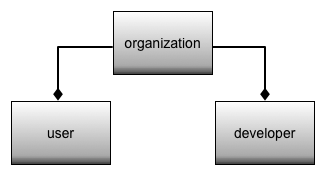本頁內容適用於 Apigee 和 Apigee Hybrid。
查看
Apigee Edge 說明文件。
![]()
所有 Apigee 使用者都稱為全域使用者,因為他們是在任何 Apigee 機構外部建立。建立完成後,即可將全域使用者指派給一或多個機構:

將使用者指派給機構時,您必須指定該使用者在該機構中的角色。使用者角色決定了使用者在該機構中可執行的動作。舉例來說,部分使用者可以建立 API,其他使用者則可以查看 API,但無法修改。
全域使用者也可以指派為 Apigee 機構管理員或 Apigee 唯讀管理員。機構管理員會執行維護 Apigee 的所有必要管理工作,包括建立新的全域使用者。
哪些資訊定義使用者?
Apigee 使用者的定義如下:
- 名字
- 姓氏
- 電子郵件地址
- 密碼
登入 Apigee 使用者介面及透過 Apigee API 提出要求時,電子郵件地址和密碼會做為使用者的憑證。
什麼是角色?
全域使用者本身無法在 Apigee 中執行任何操作。如要讓全域使用者能夠執行這項功能,必須為使用者指派機構角色。
角色基本上就是以 CRUD 為基礎的權限集。CRUD 代表「建立、讀取、更新、刪除」。 舉例來說,使用者在機構中可能獲派某個角色,允許讀取或「取得」受保護實體的詳細資料,但沒有更新或刪除該實體的寫入權限。機構管理員是機構中的最高層級角色,可以對機構中的任何實體執行任何 CRUD 作業。
關於預先定義的機構角色
所有 Apigee 機構都會建立下列角色,並具有預先定義的一組權限:
- 機構管理員
- 唯讀機構管理員
- 營運管理員
- 商業用戶
- 使用者
您也可以在機構中建立自訂角色,並設定自訂權限。
關於管理員角色
Apigee 支援下列管理員角色:
- 唯讀管理員角色
- 機構管理員角色
Apigee 機構管理員可以執行下列操作:
- 建立機構和環境
- 在 Apigee 安裝中新增其他元件
- 設定 TLS/SSL
- 建立其他管理員
- 執行所有其他 Apigee 管理工作
如要進一步瞭解管理員權限,請參閱「Apigee 角色」。
將全域使用者指派給機構
下圖顯示 Apigee 機構的結構:

機構包含兩種不同的使用者類型:
- 機構使用者:建立、修改及部署 API,建立及管理 API 產品、開發人員和開發人員應用程式等實體,產生分析報表,以及執行其他管理工作。機構使用者是 Apigee 全域使用者, 獲派特定角色並指派給機構。
- 開發人員:建構向 API 發出要求的應用程式。開發人員不是 Apigee 全域使用者。將開發人員視為 API 客戶。如要存取貴機構的 API,開發人員必須先向貴機構註冊,然後申請 API 金鑰。開發人員可向多個機構註冊,以便使用不同機構的 API。
機構中的使用者和開發人員之間的主要差異在於:使用者是建構及維護 API 的 Apigee 全域使用者,而開發人員是建構應用程式來使用這些 API 的客戶。開發人員通常不會在 Apigee 上擁有全域使用者帳戶,也無法登入 Apigee UI。但如果機構使用者為了測試而建立自己的開發人員和開發人員應用程式,則不在此限。
如要進一步瞭解開發人員,請參閱「發布總覽」。

